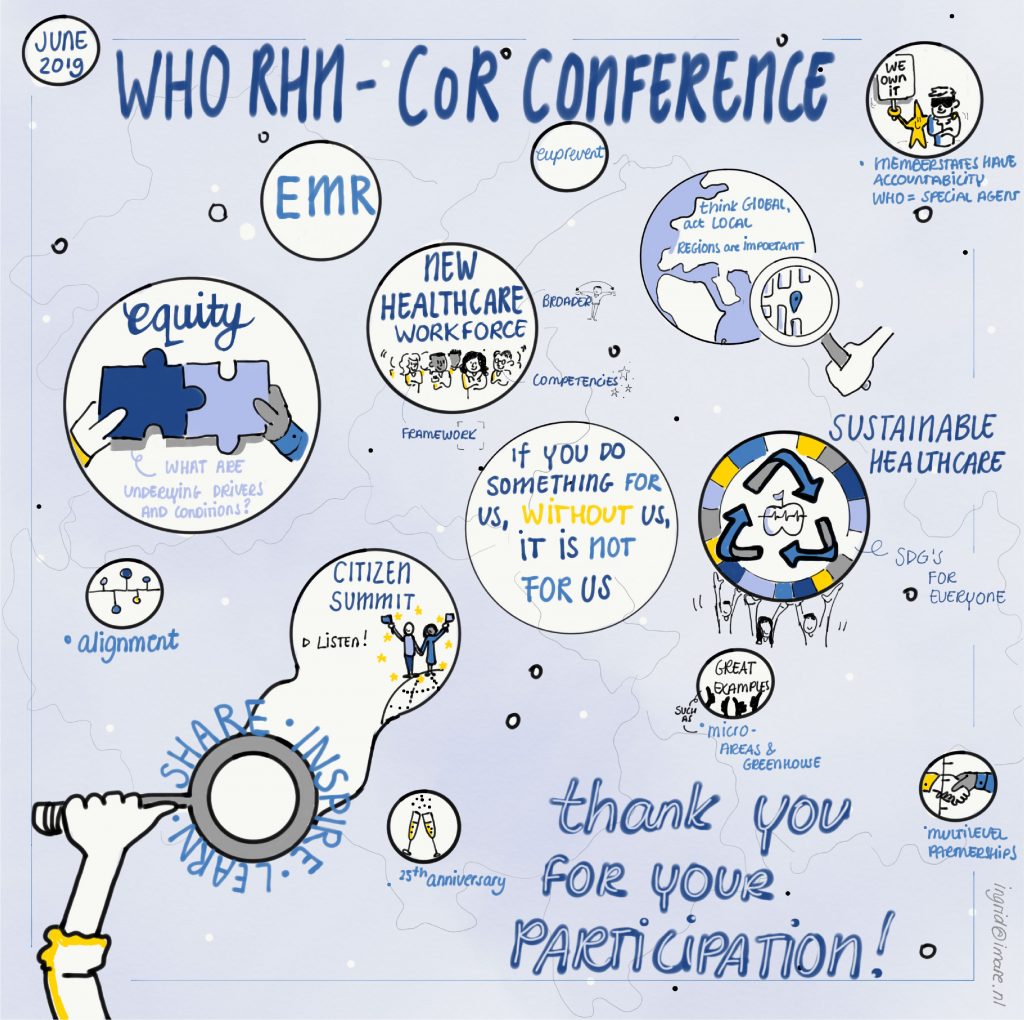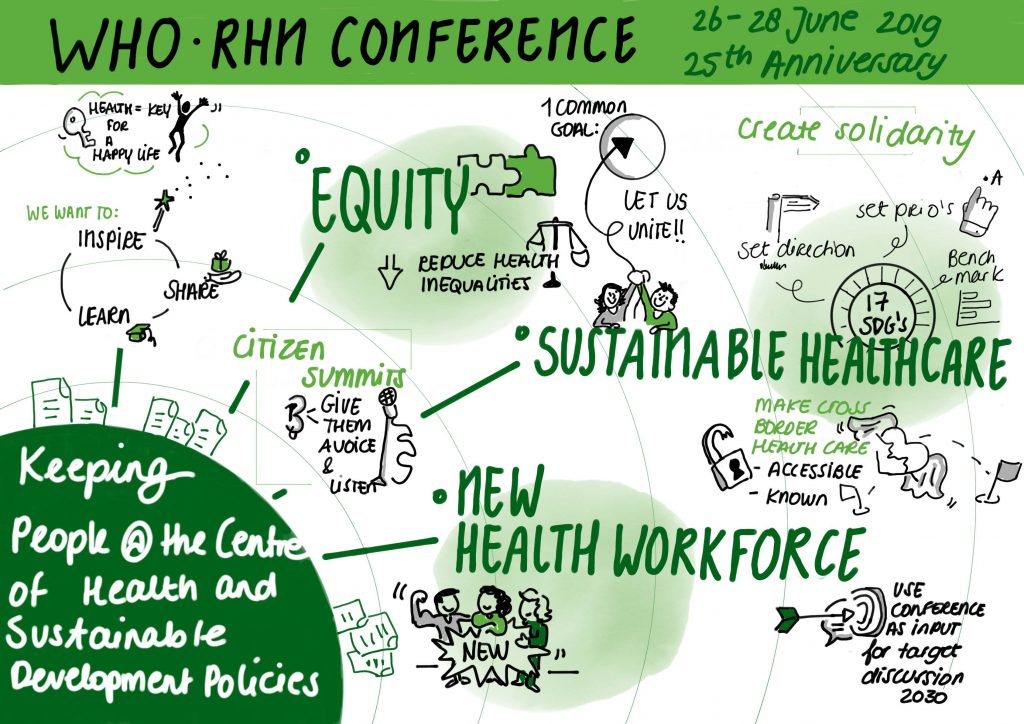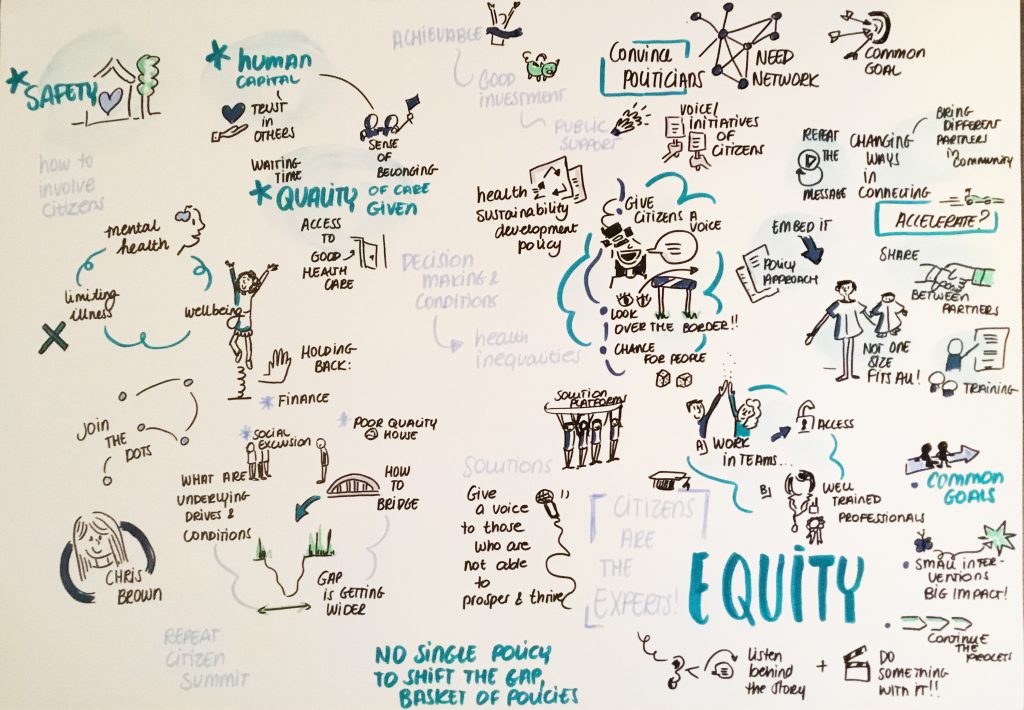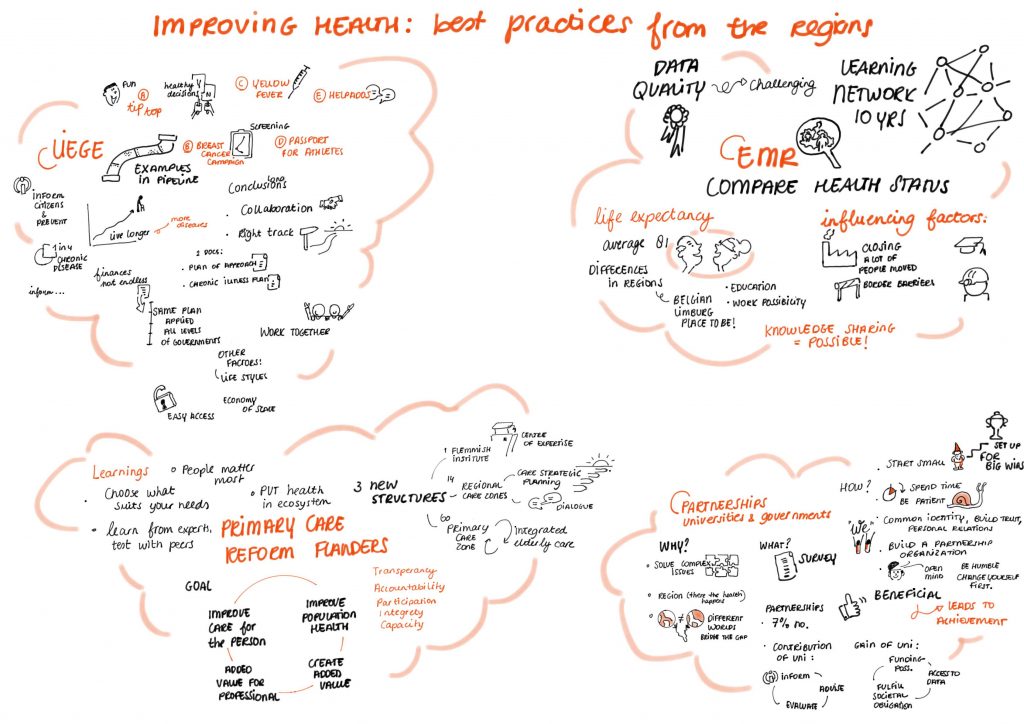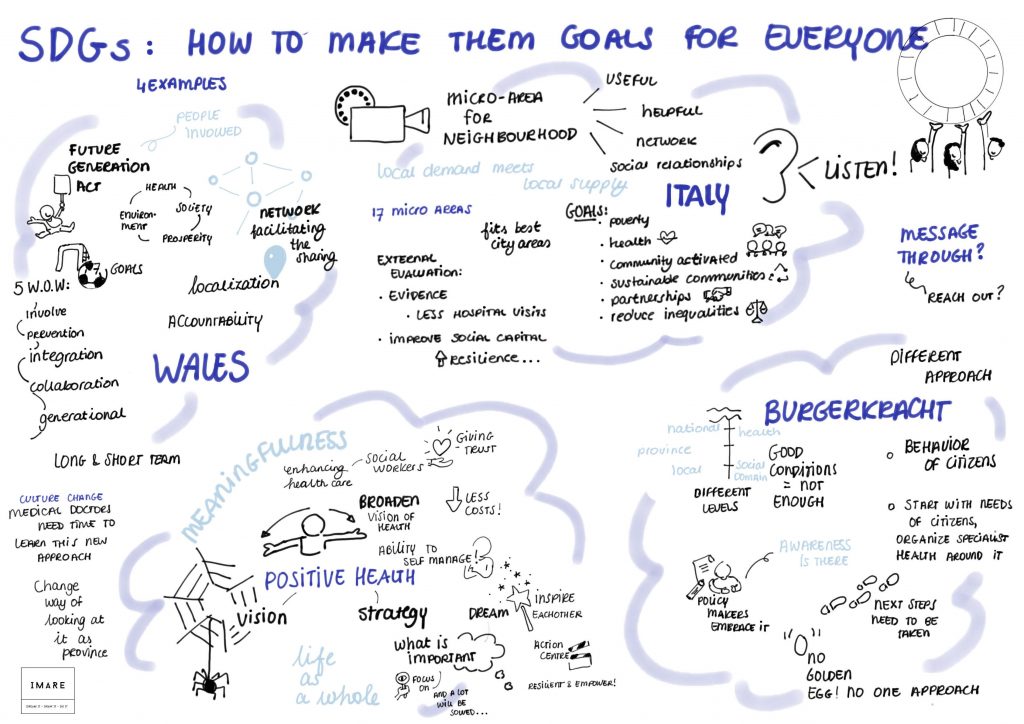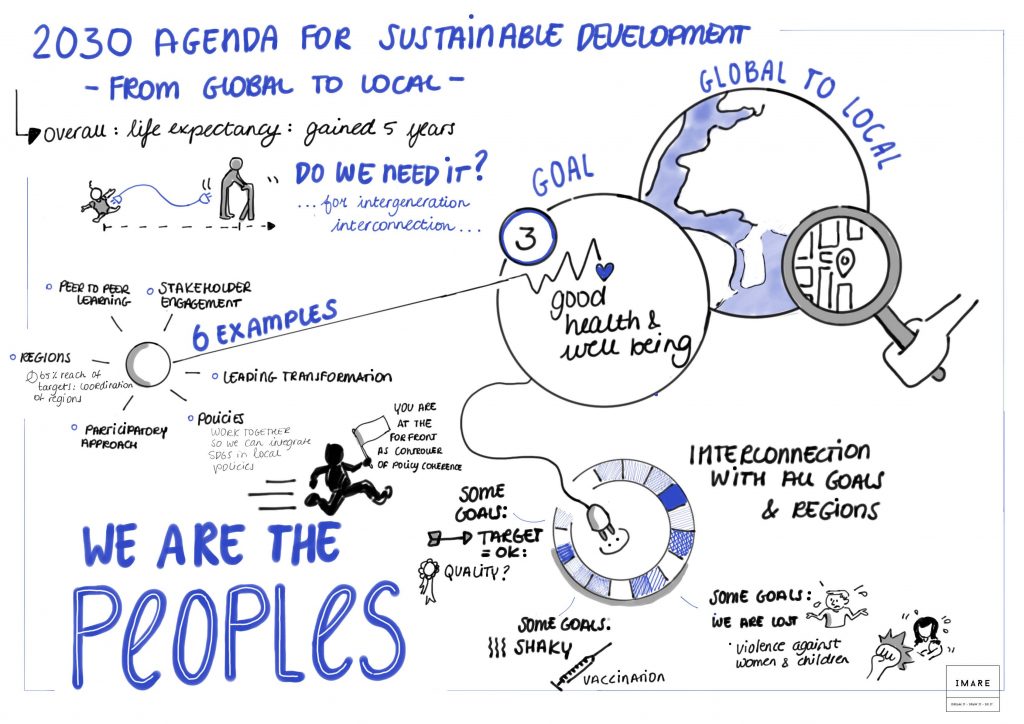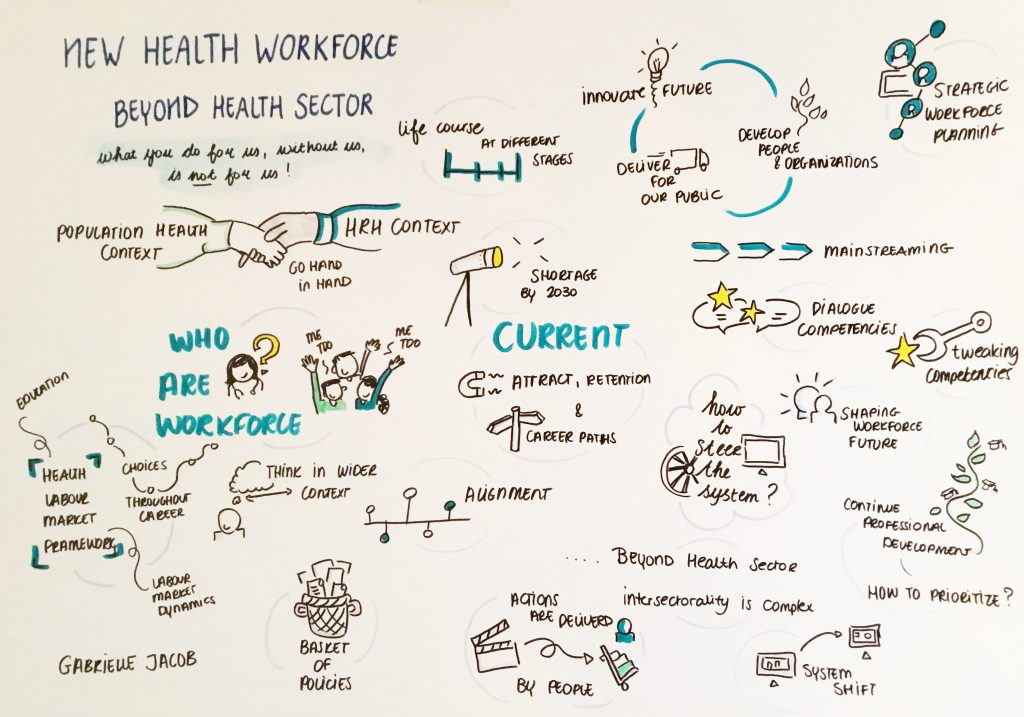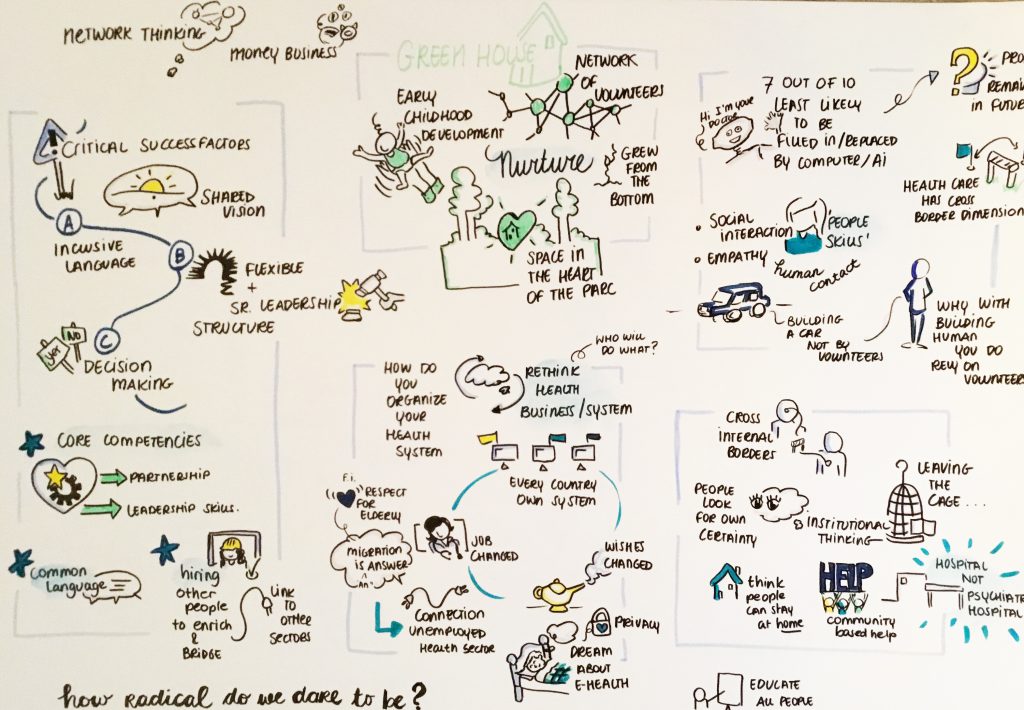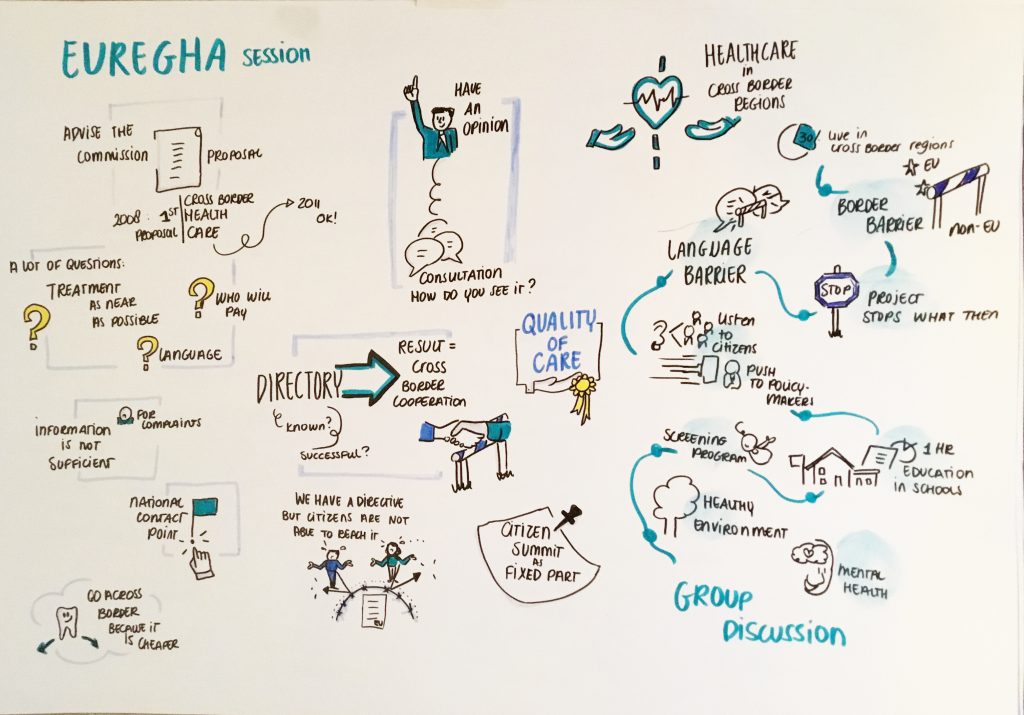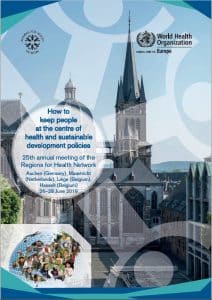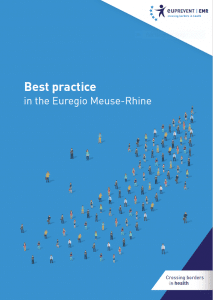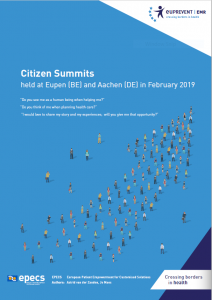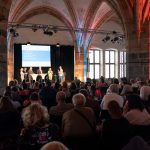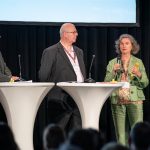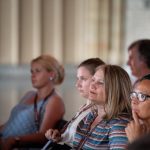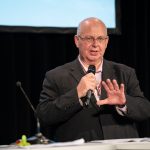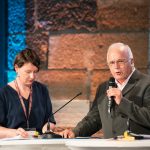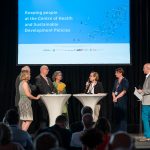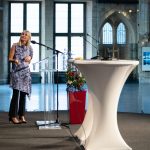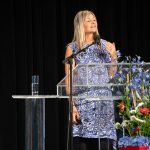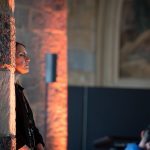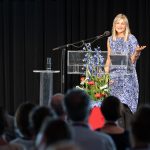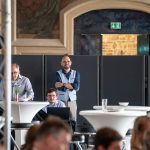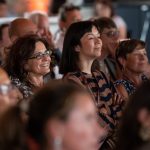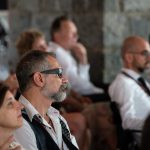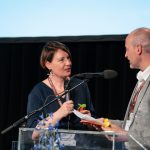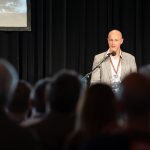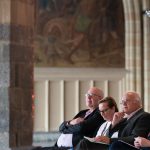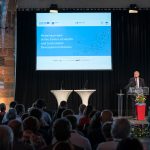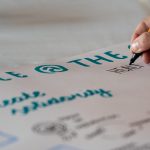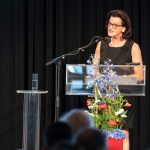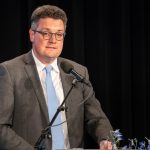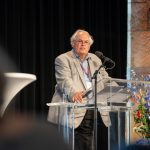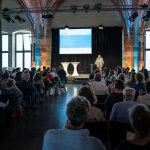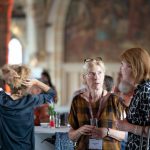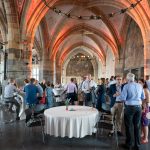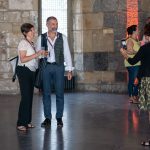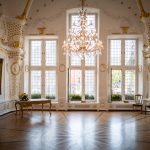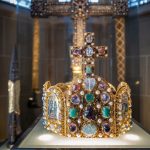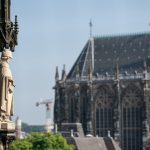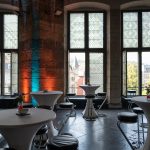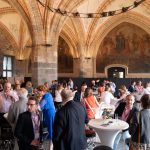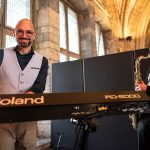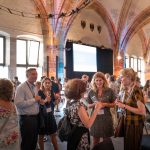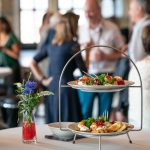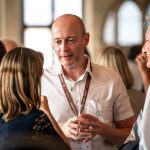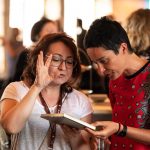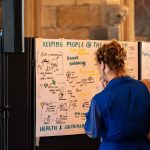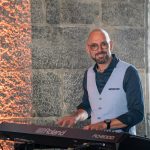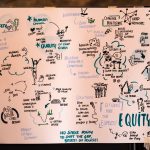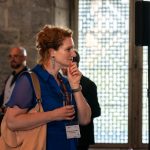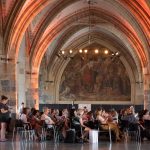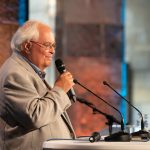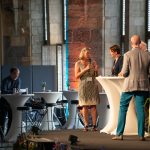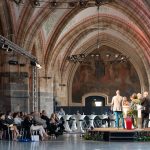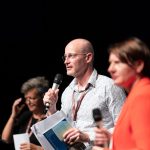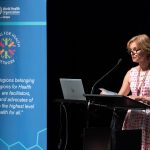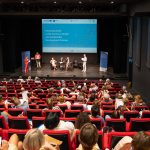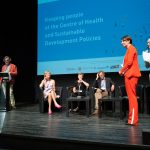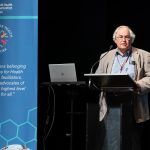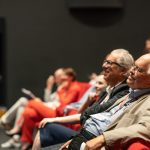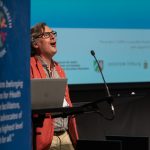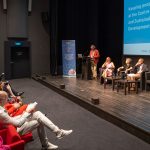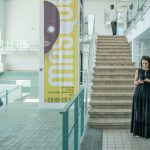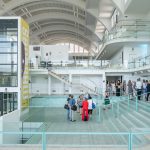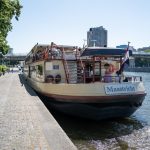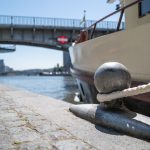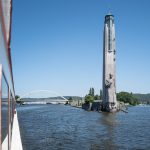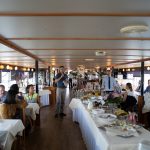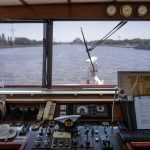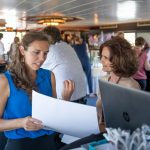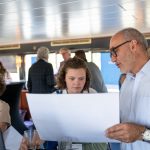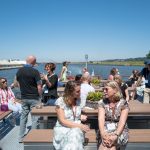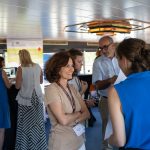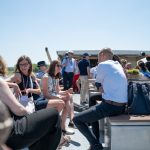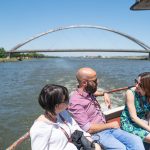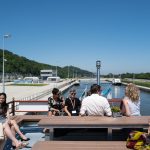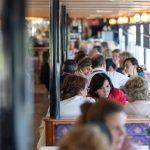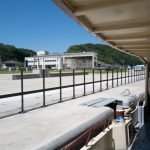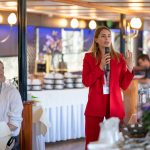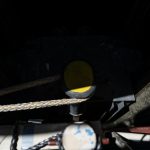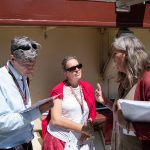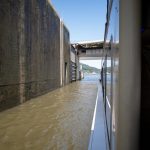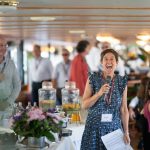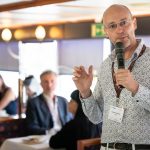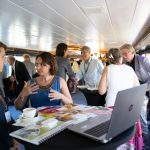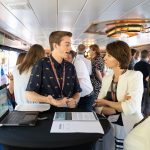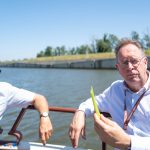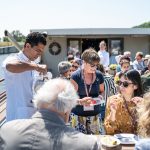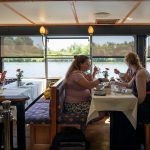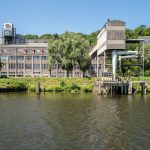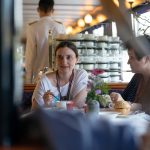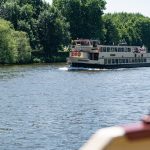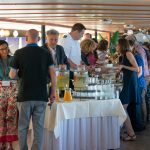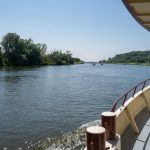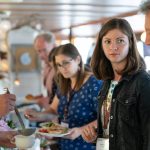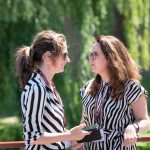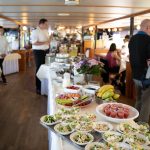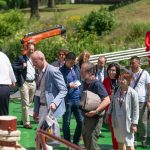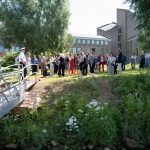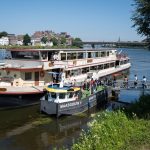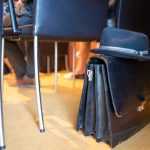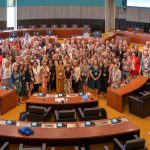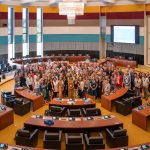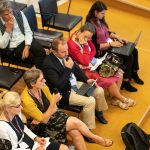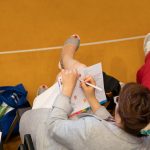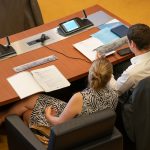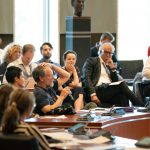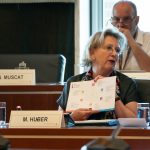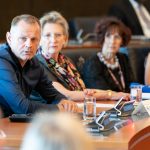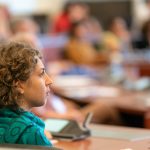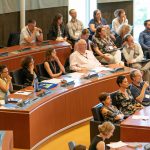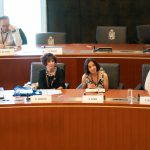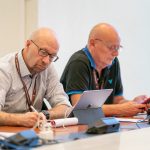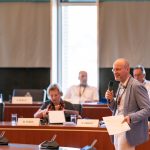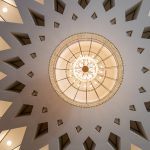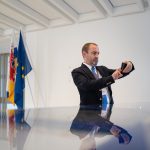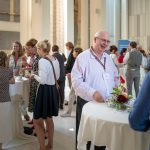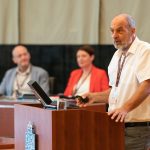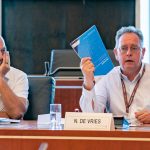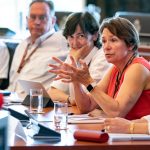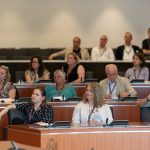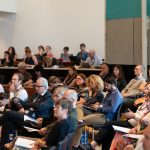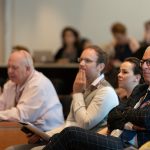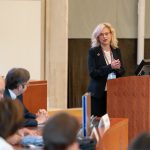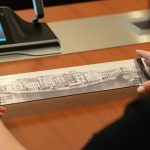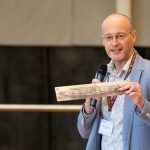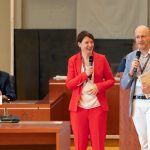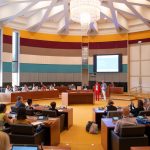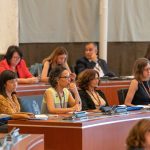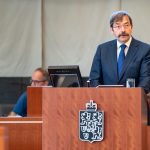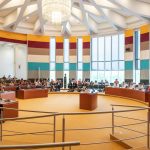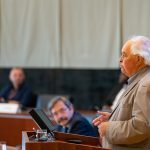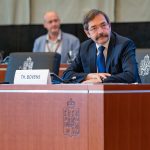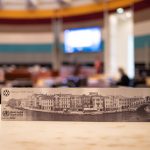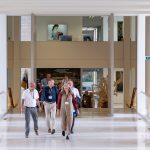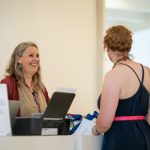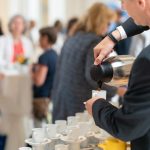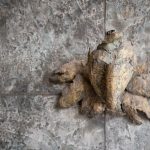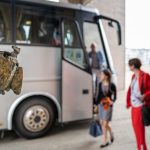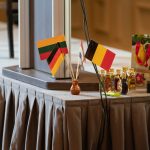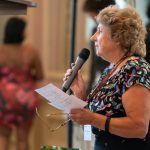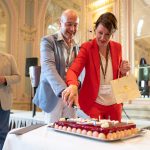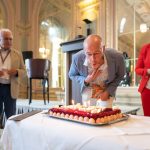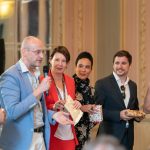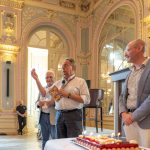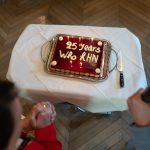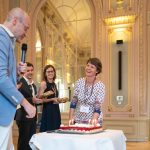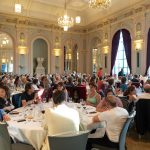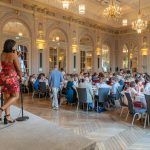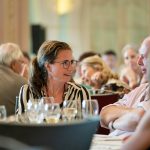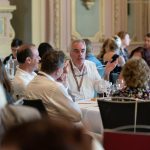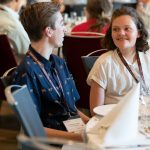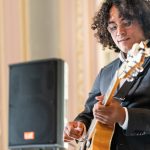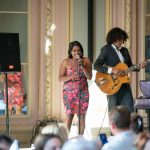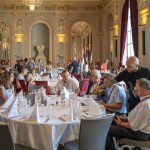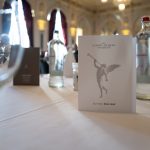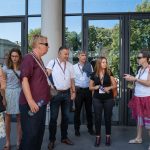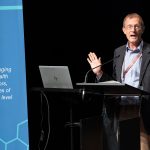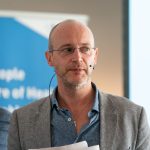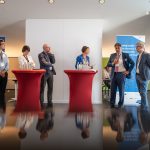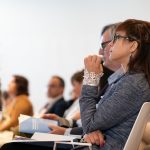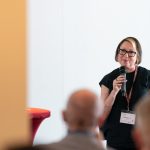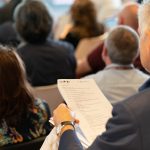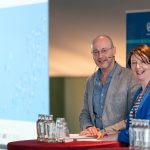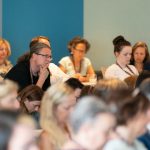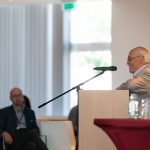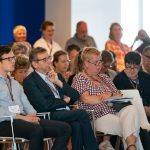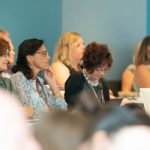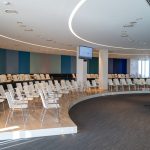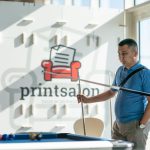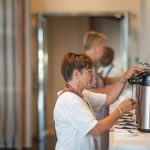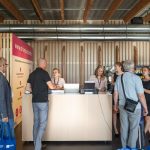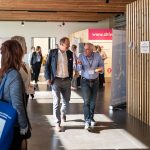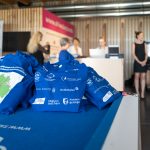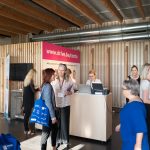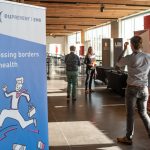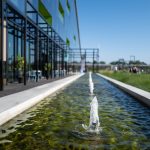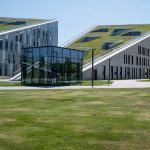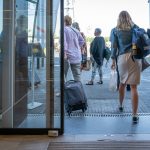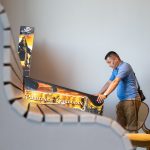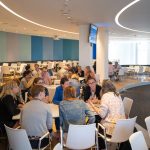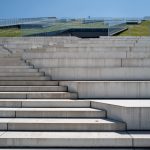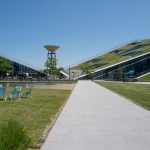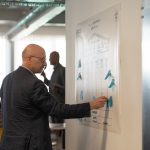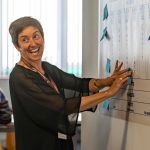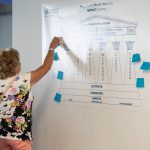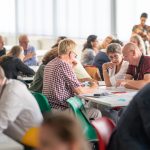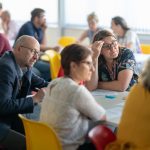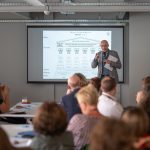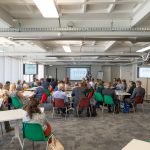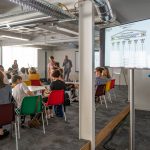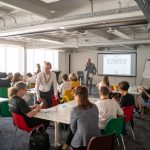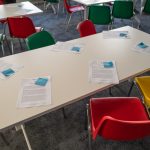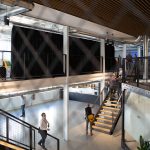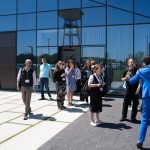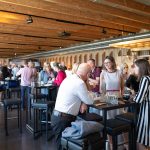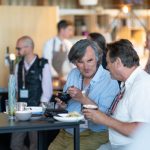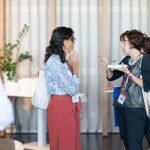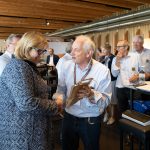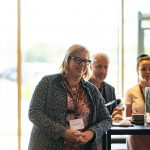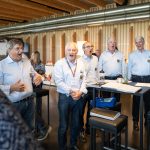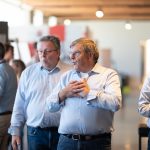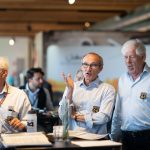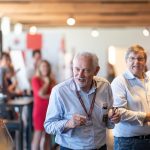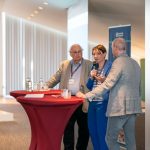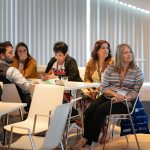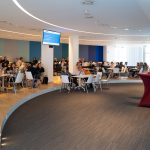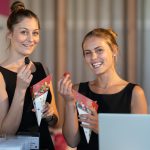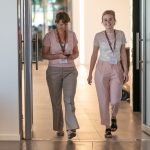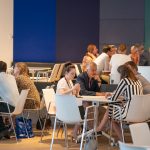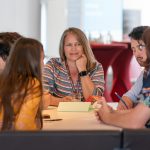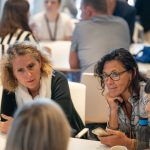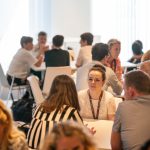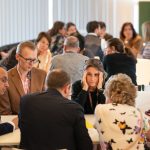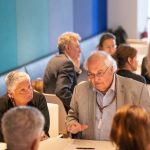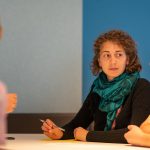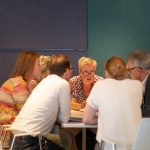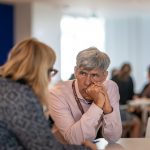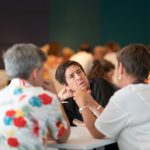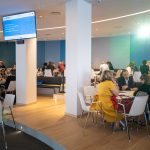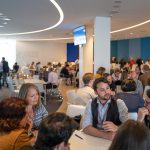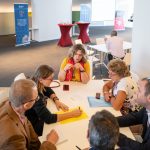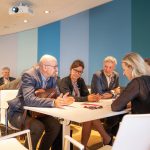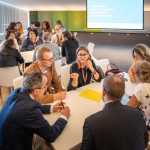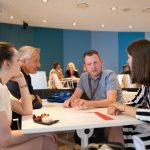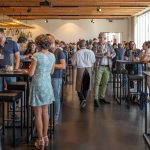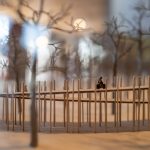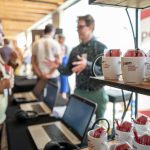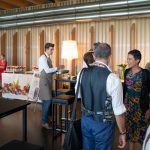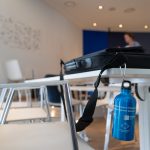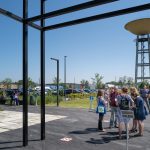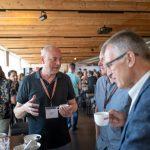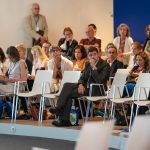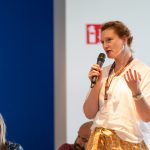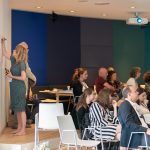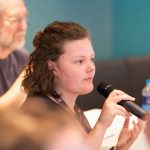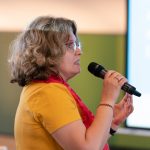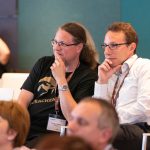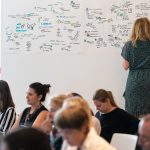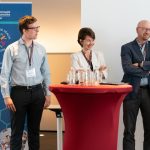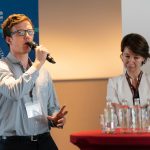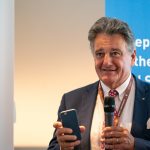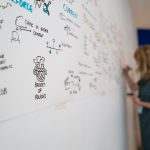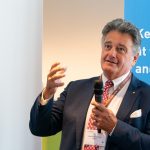Keeping people at the centre of health

Deze informatie is alleen beschikbaar in het Engels./ Diese Information ist nur in Englisch verfügbar. / Cette information est seulement disponible en anglais.
June 27th
Session 3: The 2030 Agenda for Sustainable Development: from global to local through participatory approaches
- Presentation
Ms Bettina Menne
Coordinator, Health and Sustainable Development (SDG), Denmark
Session 4: Feedback from the Citizens‘ Summit: citizens‘ view on equity, sustainable development and participatory approaches, human resources for health
- Presentation
Mr Jo Maes,
Chairman, EPECS, The Netherlands
Session 8: Improving population health: best practices from the regions
- Presentation Health status of citizens in the EMR
Ms Maria Jansen
Programme Manager, Public Health Academy, GGD South Limburg, The Netherlands - Presentation Partnerships for Health RHN
Ms Camilla Ihlebæk
Professor, Public Health Faculty, Norwegian University of Life Sciences, Norway - Presentation Primary health care in Flanders, Belgium
Mr Dirk Dewolf
General Administrator, Flanders Agency for Care and Health, Belgium
June 28th
Session 9: The new health workforce: going beyond the health sector
- Presentation Keynote speaker:
Ms Gabrielle Jacob
Programme Manager, Human Resources for Health, WHO Regional Office for Europe
Registration is closed
What will our health care system look like in the future? Will health care still be affordable and accessible for everyone? Will we still have enough sufficiently well-trained staff to meet the growing care needs?
These are all questions that the World Health Organization Regions for Health Network (WHO RHN), the European Committee of the Regions (CoR) and the partners from the Euregio Meuse-Rhine (EMR) want to be able to answer. For three days in June, experts and health care professionals from 25 countries will meet to discuss preparations for tomorrow’s health care.
The three main themes of the conference are „Equity“, „Participatory Approach“ and „Human Resources for health“.
Citizen summits
Health care of the future is not just a matter for professionals. The voices of citizens are also important. On 9 and 16 February, two citizens‘ summits were held in Eupen (BE) and Aachen (DE), where citizens of the 5 regions of the EMR gave their views on health care.
Conference
The vision of citizens is included in the three-day conference to be held in June together with experts and care professionals in Aachen (DE), Maastricht (NL), Liège (BE) and Hasselt (BE). This conference will be a starting point for developing a new strategy for the EMR that will guarantee us high-quality and sustainable health care in the future.
25th Anniversary WHO RHN
The partners in the EMR are honoured that the Who RHN is organising their 25th annual meeting in the Euregio Meuse-Rhine.
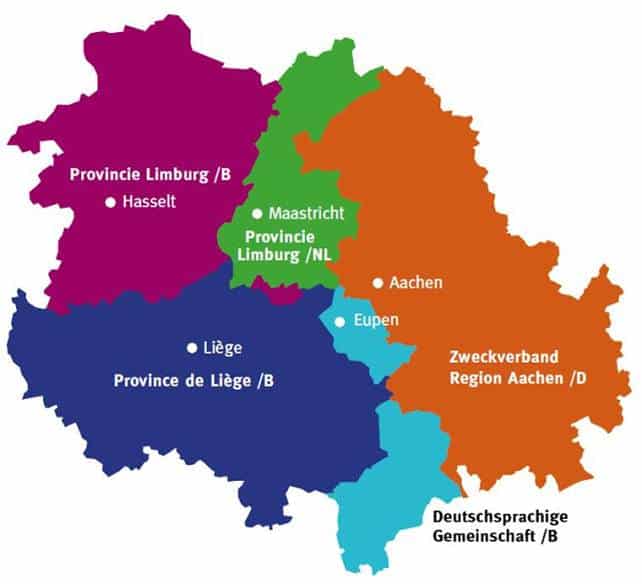
Dates
26 – 28 June 2019
Cities
Aachen (DE)
Maastricht (NL)
Liège (BE)
Hasselt (BE)
Registration
is closed
JUNE CONFERENCE
Date: 26th until the 28th of June 2019
Location: Aachen (DE), Maastricht (NL), Liège (BE), Hasselt (BE)
Wednesday 26th of June 2019
Arrival of the international guests in Aachen. International guests will stay overnight in Hotels in Aachen.
Location:
Aachen – Aachen Town Hall (Krönungssaal)
Markt
52062 Aachen
Germany
Moderator:
Mr. Nicolas Decker (Kohll-Decker ruling),
Board member, European Patients Empowerment for Customised Solutions (EPECS), The Netherlands
| Aachen | |
| 18h15 | Session 1: Welcoming remarks
|
| 18h45 | Session 2: Reducing health inequities in Europe: what can regions do? Moderators: Keynote speaker: Panel discussion:
|
| 19h45 | Reception and finger food for invited guests, including international guests, at the Krönungssaal in Aachen |
Conference day June 26th 2019
JUNE CONFERENCE
Date: 26th until the 28th of June 2019
Location: Aachen (DE), Maastricht (NL), Liège (BE), Hasselt (BE)
Thursday 27th of June 2019
Locations:
Gouvernement Maastricht – Follow Bestuursingang signs
Limburglaan 10
6229 GA Maastricht
The Netherlands
La Cité Miroir
Pl. Xavier-Neujean 22
4000 Liège
Belgium
Crowne Plaza Hotel – Les Comtes de Méan
Rue du Mont St Martin 9/11
4000 Liège
Belgium
Moderator:
Mr Nicolas Decker (Kohll-Decker ruling),
Board member, European Patients Empowerment for Customised Solutions (EPECS), The Netherlands
| Maastricht - Provincial House (Statenzaal) |
07h30 sharp | Departure by bus from Innside Hotel (international guests) |
| 07h30 – 08h15 | Transportation of international guests to Maastricht, Province of Limburg, The Netherlands |
| 08h15 – 09h00 | Registration and welcome with coffee and tea. |
| 09h00 – 09h15 | Welcome by Mr Theo Bovens Governor, Province of Limburg, The Netherlands |
| 09h15 – 10h15 | Session 3: The 2030 Agenda for Sustainable Development: from global to local through participatory approaches Moderators: Keynote speaker: Panel discussion:
|
| 10h15 – 10h30 | Session 4: Feedback from the Citizens' Summit: citizens' view on equity, sustainable development and participatory approaches, human resources for health
Mr Jo Maes, Chairman, EPECS, The Netherlands |
| 10h30 – 11h00 | Coffee Break |
| 11h00 – 12h00 | Session 5: Sustainable Development Goals: how to make them goals for everyone Moderators: Panel discussion:
|
| 12h00 – 12h10 | Family picture – in the Statenzaal |
| 12h10 – 12h30 | Boarding of the ship (going along the River Maas from Maastricht to Liège) |
| Maastricht/Liège |
|
| 12h30 – 13h00 | Lunch |
| 13h00 – 14h00 |
Sessions 6 & 7: Interaction Market and World Cafe-style discussion During this hour, participants are split in two main groups. One group starts at Deck 1 while the other starts at Deck 2. After the break, the groups swop decks. Group 1 on deck 2 of the ship: Interaction Market
Group 2 on deck 1 of the ship: World café style sessions
|
| 14h00 – 14h30 | Break and swopping decks |
| 14h30 – 15h30 |
Group 2 on Deck 2 of the ship: Interaction Market See the description above. Group 1 on deck 1 of the ship: World café style sessions See the description above. |
| Liège |
|
| 15h30 – 16h00 | Transfer by bus from boat to Cité Miroir (Restyled swimming pool) in Liège |
| 16h00 – 16h30 | Sightseeing of the location. Welcoming remarks by Mr Philippe Snoeck Director Observatoir de la Santé, Province of Liège Santé et Qualité de vie, Belgium |
| 16h30 – 17h30 |
Session 8: Improving population health: best practices from the regions
|
| 17h30 - 17h45 | Wrap up of the day Mr Nicolas Decker Board member, EPECS, The Netherlands |
| 17h45 – 18h30 | Guided walk from Cite Mirior to Crowne Plaza |
| 18h30 – 21h00 | Social programmr and dinner in Liège, Crowne Plaza Celebrating the 25th annual meeting of the RHN |
| 21h00 | Bus transfer back |
Conference day June 26th 2019
JUNE CONFERENCE
Date: 26th until the 28th of June 2019
Location: Aachen (DE), Maastricht (NL), Liège (BE), Hasselt (BE)
Friday 28th of June 2019
Locations:
Corda Campus
Kempische Steenweg 293
3500 Hasselt
Belgium
Hotel: INNSIDE Hotel
Sandkaulstraße 20
52062 Aachen
Germany
Moderator:
Mr Nicolas Decker (Kohll-Decker ruling)
Board member, European Patients Empowerment for Customised Solutions (EPECS), The Netherlands
| Hasselt |
|
| 07h30 sharp | Departure by bus from Innside Hotel (international guests) |
07h30 – 09h00 | Bus transfer from Innside Hotel to Hasselt for international guest (Breakfast available on the bus) |
| 09h00 – 09h30 | Registration and coffee and tea in Hasselt |
| 09h30 – 09h45 | Welcome by Mr Herman Reynders Governor, Province of Limburg, Belgium |
| 09h45 – 11h00 | Session 9: The new health workforce: going beyond the health sector Moderators: Keynote speaker: Panel discussion:
|
| 11h00 – 11h30 | Coffee Break |
| 11h30 – 12h30 | Session 10: Group discussion on equity, sustainable development and participatory approaches, and human resources for health |
| 12h30 – 12h45 | Closing remarks by the moderators Mr Nicolas Decker Board member, EPECS, The Netherlands Mr Francesco Zambon Coordinator, Department of Investment for Health and Development in Healthy Settings, WHO Regional Office for Europe Ms Brigitte van der Zanden Director, euPrevent|EMR, The Netherlands |
| 12h45 – 13h30 | Lunch |
| 13h30 – 15h00 | Parallel sessions
|
| 15h00 | Bus transfer to airports or to Innside Hotel, Aachen |
Conference day June 26th 2019
Wednesday 26th of June 2019
Location:
Rathaus Aachen – Krönungssaal
Markt
52062 Aachen
Germany
Thursday 27th of June 2019
Locations:
Gouvernement Maastricht – Follow Bestuursingang signs
Limburglaan 10
6229 GA Maastricht
The Netherlands
La Cité Miroir
Pl. Xavier-Neujean 22
4000 Liège
Belgium
Crowne Plaza Hotel – Les Comtes de Méan
Rue du Mont St Martin 9/11
4000 Liège
Belgium
Friday 28th of June 2019
Locations:
Corda Campus
Kempische Steenweg 293
3500 Hasselt
Belgium
Hotel: INNSIDE Hotel
Sandkaulstraße 20
52062 Aachen
Germany
Hotels Aachen (DE)
Aquis Grana Cityhotel
Buchkremerstraße / Büchel 32
52062 Aachen
Germany
Boasting a privileged location within the centre of the historic old town of Aachen, the Aquisgrana Cityhotel features a total of 98 modern and comfortably furnished non-smoking rooms. Soundproof windows ensure a break from the hustle and bustle of the city. The 4-star hotel features also a lot of facilities such as business lounge, hotel bar, free use of Wi-Fi, underground car park and four conference rooms for 60 people.
www.hotel-aquis-grana.de/index.php/en/
Conditions/extras
Check In: 2.00 p.m.
Check Out: 12.00 p.m.
Directions
You can only reach the hotel by car by using the Peterstrasse / Ursulinerstr.

Mercure Hotel Aachen am Dom
Peterstrasse 1
52062 Aachen
Germany
The hotel is located in the heart of the old Carolingian city of Aachen with world-famous sights such as the imperial cathedral and the Carolus thermal baths. Our 3-star superior Mercure Aachen am Dom has 117 rooms with free Wi-Fi. Car: the hotel is 3 km from the A544 motorway; parking in the public car park near the hotel (for a fee).
www.accorhotels.com/gb/hotel-5326-mercure-hotel-aachen-am-dom/index.shtml
Conditions/extras
Check In: 3.00 p.m.
Check Out: 12.00 p.m

Tourist info
Top five attractions Aachen (DE)
1. Aachener Rathaus
The historic rooms in this impressive building contain an interactive exhibition. You might even see the mayor of Aachen at his desk.
The historic façade is already an indication of the building’s glorious history: 50 rulers, 31 of whom were crowned in Aachen, surround the central figures of Charlemagne, the Holy Mary and Pope Leo III. In the elaborately decorated rooms, too, the story of the city hall, which was built on the historic site of the great palace hall of Emperor Charlemagne, is brought to life. In the coronation hall, where formerly the rulers took a meal after being crowned, copies of the imperial regalia remind us of this glorious era today.
Visit the town hall
Daily 10 a.m. – 6 p.m.
Please note that rooms may be closed due to special events!
Entrance € 6,- and € 3,- reduced price
More info on rathaus-aachen.de/en/town-hall

2. Aachen Cathedral
Located in the heart of the old city, Aachen Cathedral is one of the main attractions of Aachen. Its architecture and features still highlight the significance and imposing nature of the building, which was completed at the end of the 8th century at the request of Emperor Charlemagne. Its magnificent interior is in full view as soon as you enter. Here, history really does come alive.
The cathedral is closed to tourists during services. This also applies to special services and concerts – short-term closure is possible!

3. Katschhof
On the Katschhof square, which used to connect the Marienkirche church built by Charlemagne and his great palace hall, you’ll find the Centre Charlemagne, Aachen’s new city museum. Here, you can immerse yourself in the history of Aachen. From the stairs of the city hall, you also have a unique view of Aachen Cathedral. The atmosphere in the square is unbelievably peaceful – a real retreat away from the hustle and bustle of the city.
4. Elisenbrunnen
Located in the heart of the city, the Elisenbrunnen fountain is the symbol of Aachen as a spa and bathing city. Here, the hot springs, which were valued not only by Charlemagne, but also the Romans, can be seen bubbling up from below. The classicistic building with its two fountains is a popular meeting place for young and old, Aacheners and non-Aacheners!

5. Carolus Thermen
In Aachen, water and wellness have a long tradition. While in former times, the Romans relaxed in the therapeutic waters of the Aachen mineral springs, today, the Carolus Thermen thermal pools offer the perfect escape from everyday life.
In the thermal spa, you’ll find a range of different indoor and outdoor pools, all of which are filled with beneficial thermal water. In the summer, the Carolus beach, with its sand and beach chairs, offers a real holiday atmosphere! If you still want a real workout in the middle of your relaxing day, you can join a free aqua gymnastics session.
More info on www.carolus-thermen.de/en/thermalbath

You can find more information about the city on www.aachen-tourismus.de/en
Top five attractions Liege (BE)
1. La Cité Miroir
Right in the centre of Liège, in January 2014, the former Thermal Baths of La Sauvenière became La Cité Miroir, a cultural and citizen space. Theatre, music, conferences, debates, workshops, permanent and temporary exhibitions, the diversity and wealth of activities make this a venue for unique expression dedicated to citizenship, memory and cultural dialogue.
The spirit of the former Thermal Baths was retained during the renovation, which imbues a unique atmosphere on this 13,000 m² building which is symbolic of Liège. Three non-profit associations share the space at La Cité Miroir: Les Territoires de la Mémoire, the Centre d’Action Laïque de la Province de Liège and MNEMA, which manages the venue.
Many external operators also use the venue for their events, all related to the values that are defended by La Cité Miroir. In a rapidly evolving city, La Cité Miroir is helping to shape the new identity of Liège by increasing ties with other cultural and association operators, protecting a listed heritage building, regenerating the Neujean district and meeting the expectations of an enlightened and demanding public.
More info about the history of La Cité Miroir on www.citemiroir.be/en/la-cite-miroir/history

2. Le Palais des Princes-Évêques
On the Place Saint-Lambert, in the city centre, the Prince-Bishops‘ Palace is one of the iconic buildings of Liege One part currently houses the provincial government, while the court is located in the other half. The current Prince-Bishops‘ Palace was preceded by two constructions. The first one was built during the episcopate of Notger and disappeared during 1185. The second construction suffered the same fate in 1505. Most of the splendour and originality of the actual palace is owed to Erard de la Marck. The first courtyard solely of is open to visitors.

3. Saint Paul Cathedral
The collegiate church of St. Paul, founded in the 10th century, in the 19th century became the new cathedral of Liège, replacing the cathedral of Saint-Lambert which was destroyed in the Liège revolution. Stained glass windows from the 16th century and contemporary period, a Baroque white marble Christ recumbent by Del Cour, exceptional 19th century furniture. The cathedral has one of the finest Gothic cloisters in the country.
Opening hours
Cathedral: open every day from 8 am to 5 pm.
The Treasure: open from Tuesday to Sunday, from 2 to 5 pm.

4. Liège-Guillemins Train Station
The station, designed by Santiago Calatrava, reaches a height of 40 metres and, with its two awnings, a width of 150 m. Opened in 2009, it took over ten years to build due to the need to keep it operational
during the construction work. With its enormous glass roof that lets the light in, it is often called a ‘cathedral of the modern age’. Its white colour and forms denote the style of Santiago Calatrava, the great Spanish architect of worldwide fame. Although modern, the station bears in the ancient name of Guillemins, referring back to a religious order, the ‘Guillemites’. The order was founded St William and established itself in the Middle Ages.
5. Montagne de Bueren
With its 374 steps and an incline that reaches 30%, the mountain of Bueren is reputed to be one of the world’s ten most extraordinary staircases. Permanently open to the public, this site is among the unmissable locations in the city of Liège. A work of art that’s characteristic of 19th-century breakthroughs, the mountain of Bueren enabled a direct link between the barracks at the citadel and the city centre.
The name of this flight of stairs recalls the aborted coup by the 600 Franchimontois. Led by Vincent de Bueren and Gossuin de Streel, they attempted to capture Charles the Bold and Louis XI during the night of 29 October 1468.

You can find more information about the city on www.visitezliege.be/en
Top five attractions Maastricht (NL)
1. Government on the Meuse
The Government of the Maas lies alongside the river Maas in Maastricht. For a small portion even on an island in the river. It was built between 1983 and 1985. The Government on the Meuse employs approximately 1,000 people. There is an office area for staff and administration area for the provincial government. Special areas in the administration section are the State Hall and Festival Hall.
In 1992 the Ministers of Foreign Affairs and Finance of the countries of the European Community in the Council Chamber, signed the ‚Maastricht Treaty‘. This treaty made the European Community into the European Union. And the treaty laid the foundation for the introduction of the euro. The Maastricht Treaty has received the European Heritage Label in 2018. You can visit The Government to see one of the two Dutch official copies of the treaty.

2. Vrijthof Square
The heart of the city is home to the beautiful Vrijthof square. This special square has become famous as the backdrop to the summer concerts of André Rieu, Preuvenemint, and the Magical Maastricht event.
For most of the year, you can walk around Vrijthof square at your leisure and take in the breathtaking panoramas. Around Vrijthof square are numerous historic buildings that hark back to the time when Maastricht was a religious centre and a military fortress, such as the Basiliek van Sint Servaas (Basilica of St. Servatius), Sint Janskerk (St John’s Church), Spaans Gouvernement Museum, the Hoofdwacht (Main Guardhouse), and the Generaalshuis (General’s House).
You will also find countless fantastic terraces and beautiful hotels that are frequented by visitors and residents of Maastricht all year round. This romantic and historic square is the largest in Maastricht.

3. City Park
Come explore the rich history in and around the city park. Climb the centuries-old city walls to take in the beauty of Maastricht for a moment. If you enter the city park from Prins Bisschopssingel, you will soon come across the bear pit. Real bears used to live there; but this couldn’t go on forever, of course. This is why the bear pit has been given an artistic purpose. Walk further on, and you will encounter the statue of D’Artagnan. This special monument in the city park commemorates the musketeer who was killed at Tongeren Gate on 25 June 1673.
Find a space on the lawn next to the cannons and enjoy some beautiful sunny weather, or walk along the historic city walls and relish the beautiful view over the city park. There are many hidden gems around the city wall and the city park. Once you have walked under the imposing Helpoort (Hell’s Gate), you will end up in the romantic Jeker quarter (Jekerkwartier).
4. Dominicanen Bookshop
Two hundred years ago, the church lost its sacred function and has since served for many years as a reptile house, bicycle shed, and ‘carnival temple’. Dominicanen bookshop has a wide range of public books, music, and books for professionals. Yet as this place even attracts those who are not so much interested in books, it is a must-see location if you are in Maastricht.
In the Dominicanenkerk’s former choir, you can enjoy a delicious cappuccino or lunch provided by the famous Blanche Dael Coffeelovers (Maastricht’s ultimate roasting house). A walk through the Dominicanenkerk is an experience in itself: it’s no wonder it’s called the most beautiful bookshop in the world!

5. Fort Sint Pieter
The fort dates from around 1700 and is largely still intact, with parts recently restored. The fort is made up of several levels and is equipped with various large and small cannons and mortars. Your guide will show you beautiful and interesting spots in and around the fort, taking you back in time.
If you’re not afraid of the dark, you should visit the famous Caves of St. Pieter. In the course of centuries of marl quarrying, an underground labyrinth was created here with over 20,000 passageways.
The manual labourers who cut out the blocks as well as various artists have left their marks, including various interesting and sometimes very old writings on the wall.
More info on www.maastrichtunderground.nl/eng

You can find more information about the city on www.visitmaastricht.com
Top attractions Hasselt (BE)
1. Corda Campus
On 2 March 1954, the City of Hasselt and the technology company Philips signed an agreement to build a Philips factory south of the Hasselt-Genk railway line, in the Banneux neighbourhood. Fast forward a few years, and record players, tape and cassette recorders, and loudspeakers were assembled, and metal parts were produced at the newly built production halls and office buildings. The Philips Hasselt site was the first branch outside of Eindhoven to also design products in-house. In 1964 Philips Hasselt developed and produced the first ever ‘Philicorda’ organ (do we hear ‘Corda’ there?). Throughout the years the staff base soared and so did the number of new products. Unfortunately, Philips encountered some difficulties in the early noughties and in late 2002 the 1,450 remaining employees were informed the factory was closing down.
The Philips buildings then became part of the ‘Research Campus Hasselt’, whose name soon needed an upgrade as it no longer reflected the real scope of the campus. In 2013 the site was renamed ‘Corda Campus’, the economic epicentre of Limburg.
Green symbolises peace and tranquillity. Corda Campus borders the Bokrijk woods and the Kiewit lakes, and is just a stone’s throw from the world-renowned Hoge Kempen National Park. The Corda Campus outdoor area perfectly reflects these natural surroundings. The central courtyard is a green oasis, with fountains and relaxation corners, whereas the campus architecture seeks to strike a balance between work and leisure.
Corda Campus decided to convert an existing, but vacant warehouse into a car park. The Corda1 building has a slanting green roof which provides thermal insulation and acts as a rainwater buffer. The building’s HVAC system is linked to geothermal applications (geothermal heating and heat pumps). And last but not least, during the renovations of the older buildings, Corda Campus systematically takes account of sustainability criteria.

2. The Lively City
With its restaurants, shop facilities, city museums and kind people, a visit to the city centre of Hasselt is definitely worth.
- Z33 – House for Contemporary Art
Z33 creates projects, exhibitions, productions and publications by and with artists. Contemporary art, architecture, design and film are used to bring to the fore and critically examine a variety of social themes. Z33 aims to question the norm, encourage curiosity, and provide a new frame of reference, but also seeks to provide knowledge, skills and tools to its public so as to set things in motion. Z33 has a particular focus on talent development as well as on projects that stimulate new connections between artists, designers, researchers, scientists and (urban) residents.
You can find more information at www.z33.be
- Fashion Museum
The collection of the Modemuseum Hasselt (Fashion Museum Hasselt) counts just about 17,000 items ranging from clothing, shoes, handbags, accessories to undergarments. The collection policy is aimed at acquiring and conserving historical pieces of clothing as well as items from contemporary designers and keep them in the most optimal conditions.
You can find more information at www.modemuseumhasselt.be
- Jenever Museum
Hasselt is still the jenever city par excellence. You’ll see the proof of this in the Jenever Museum. You’ll learn everything you need to know about jenever here. Don’t forget to enjoy your free drink in our tasting room.
A fully operational19th century distillery, 2.150 glass bottles, 750 jugs and pitchers made of stone, more than 1.230 jenever glasses and 400 liqueur glasses, 200 ceramic objects, 540 posters, 380 placards and approximately 9.500 bottle labels.That sums up the Jenevermuseum’s collection.
You can find more info at www.jenevermuseum.be.

You can find more information about the city on www.visithasselt.be/en
3. In search of green
Come to yourself in the oriental fauna & flora setting from the Japanese Garden
The Japanese Garden in Hasselt is the largest of its kind in Europe, the perfect place to fully experience Japanese culture. Originally, a Japanese garden encouraged meditation and reflection, which is no different in Hasselt.
You can find more info on www.visithasselt.be/nl/japanse-tuin
Go out and discover the rich history at about 15 min from the Corda Campus.
- Herkenrode Abbey
The Herkenrode Abbey is a monastery of Cistercian nuns since 1927. It was also the first women’s abbey and has gone through so much over the years. From decay periods to booming ones, this land has gone through it all. But after almost a century, the building still stands strong and is surrounded by beautiful natural reserves. They have an experience center and inspiration garden that are accessible to everyone. Plus, their symbol is a unicorn! Find out more by visiting the abbey, especially during the Unicorn Sage Family shows on Pentecost day.
You can find more info on www.abdijsiteherkenrode.be

- Bokrijk
In Bokrijk you can dive into the distant past. During your fascinating trip through the Open Air Museum you will discover more than hundred authentic buildings with old objects and craftsmen in the apparel of former times. In the information centre opposite Bokrijk castle you will find all the information you need, along with activity programmes, maps and rental bicycles. At this moment you can visit the interactive exhibition ‘The World of Bruegel’. The inspiring Bruegel Trail will allow you to immerse yourself in one of the paintings of the Flemish painter Pieter Bruegel the Elder and to discover, in a pleasantly surprising way, how relevant his work remains today. You can also explore the domain and enjoy the greenery and silence of nature by walking or cycling along the beautiful ponds and enjoy the fauna and flora.
You can find more info on www.bokrijk.be/en

The WHO RHN – CoR Conference is possible thanks to funding from the People to People project Interreg V-A Euregio Meuse-Rhine and support from the European Regional Development Fund (ERDF) within the framework of the Interreg V A programme EMR.

